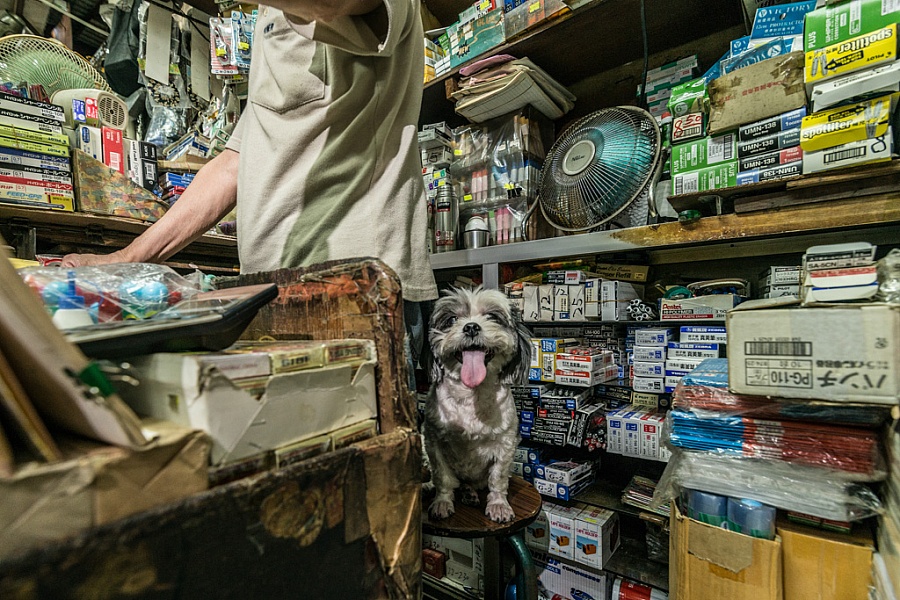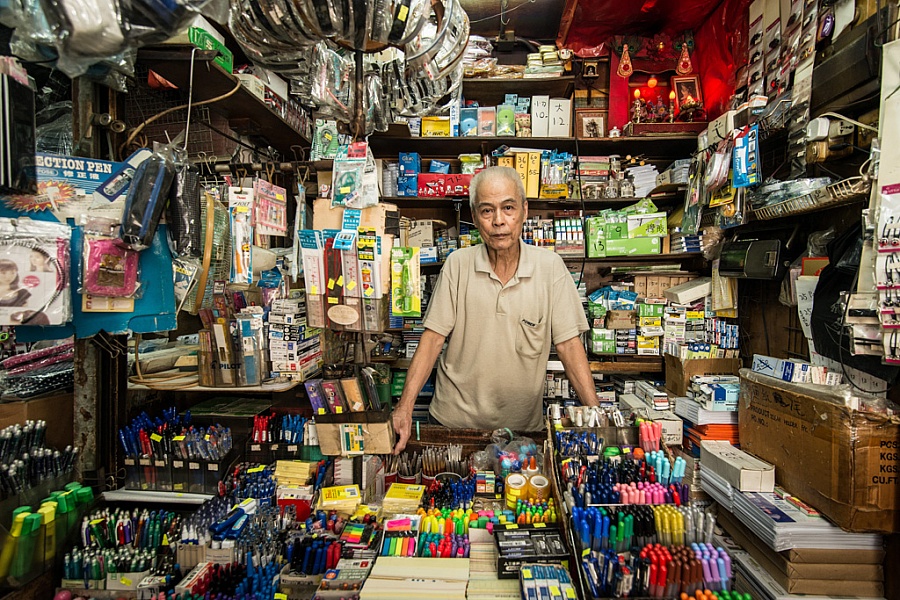If Lo Hoi didn’t show me his private collection, I would never know there are melon-green and bluish-grey correction pens. That’s what he would later sell to me even though that meant he had to part with the very last pens in his special collection. He told me correction pens used to come in different colours other than the single white ink option that we are familiar with today.
Lo Hoi is a very interesting old man. He has been selling stationery for 39 years. The 74-year-old runs his business from a 24 sq ft stall in Mut Wah Street Temporary Market. Unsurprisingly, in his long career as a stationer, he has developed an affinity with particular brands and products.
His favourites are the “Made in Japan” stationery. He keeps them in various hidden corners of his tiny stall and would only show them at the request of long-standing clients. The hidden treasures include rainbow-coloured pencils, Hello Kitty and Kerokerokeroppi pencil boxes made in early 1990s, and Bad Badtz-Maru notebooks.
I asked the stationer to tell me his story because it is also a story of Kwun Tong’s town centre, Yue Man Square.
Lo Hoi used to be a mechanic. He has been living in the Yue Man Square area since the 1960s. Before moving to Kwun Tong, he lived on Castle Peak Road in Sham Shui Po. He moved because his employer built a new plant in Kwun Tong and everything was transferred there. “It was a plant that produced machineries. It was one of the biggest such plants in Hong Kong,” said Lo Hoi.
The plant’s first relocation took Lo Hoi to Kwun Tong. Its second relocation would cost him his job. He worked in the Kwun Tong plant until 1987 which was when his employer decided to move the entire operation to Shekou, Shenzhen. All workers were made redundant. The site where the massive plant once stood is now part of the Millennium City cluster of commercial buildings in Nagu Tau Kok.
The mechanic found a new job at a Wan Chai five-star hotel very quickly after he was laid off. He was responsible for the smooth operation of the hotel’s laundry room. He would go on to work in this same hotel until his retirement.
However, the story of his stationery stall began much earlier, in 1974. Lo Hoi and his wife started as illegal hawkers but they were given a hawker license shortly afterwards.
“We started the business under my uncle’s advice. He ran a stationery store on Chun Yeung Street in North Point. I’ve got four kids. Money was always tight. He was worried so he gave me some stationery to sell in Kwun Tong. We sold the stationery from a cart on Tung Ming Street. Very quickly, the Urban Council gave us a hawker license. In those days, getting a hawker license was very simple. The officers would make frequent inspections and if they always found the same person doing business in the same place, they knew you’re genuine, and they would issue you a license. The license was under my wife’s name. I had a full time job; she was the one who looked after the business in those days.”
Lo Hoi came to Kwun Tong in the 1960s. He lived on Tung Ming Street for some 20 years before moving with his wife to nearby Yue Man Centre on Ngau Tau Kok Road where they’re still living up to this day.
For the old man, Yue Man Square is his world. He lives, works, shops and eats in this same neighbourhood. Everything that he needs is never more than a few minutes away.
“Yue Man Square is the commercial area. It has many shops, banks, and there were even department stores in the past. We used to have nine restaurants there, from upmarket places to reasonably priced options. There used to be a Japanese department store and a Chinese products department store. Wan Chai is the only other place I’m familiar with in Hong Kong so I think I can say I’ll get lost once I’m out of Kwun Tong.”
He misses the Yue Man Square of old, not least because there used to be many restaurants he could choose from for yum cha. Nowadays, the only dim sum option he’s got is the cooked food centre inside the local market. “Yue Man Square used to be very vibrant and energetic. Many people have moved out because of the area’s redevelopment by the Urban Renewal Authority (URA). My business is severely affected because of this. It used to take three people to handle the extra business that we would get at the start of every school year. Now I can do it all by myself.”
Lo Hoi reminisced that the 1980s and early 90s were the golden days of his business. The first blow came soon after when factories in the area started moving to the mainland. He lost a significant chunk of his business as the factory closures took with them many workers who didn’t necessarily live in Kwun Tong but would always go to his conveniently located shop to buy stationery for their children. Now the URA’s redevelopment is displacing many of his remaining clients. His stall will also have to move because the market that he is in will be bulldozed (finally, after being a temporary market for over 30 years, which is yet another curious fact of urban life in Kwun Tong).
Like Dickson, the old man has no plan to leave Kwun Tong. “The place is great, all my friends are here and the district is very convenient. I can’t think of anything bad about Kwun Tong. The only criticism I have is the redevelopment. The way the URA is going about it is creating discontent. What it should do is build a few new blocks and allow people to move in. Many people have a strong sense of belonging to Kwun Tong, they don't want to move out. But the URA is not giving them any choice. This is a very bad practice.”









